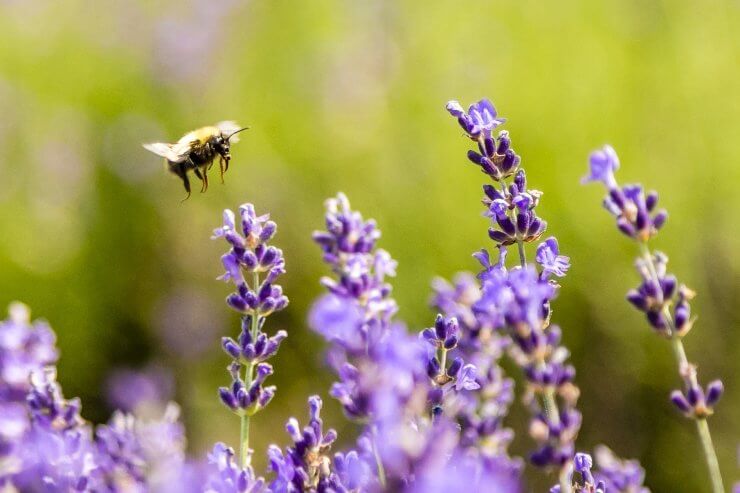
Lavender and bumble bee
Like all herb and food crops, lavender is susceptible to various fungal diseases. Your strongest weapons against these are best planting practices, which help prevent disease in the first place.
This is especially important, as there are no fungicides approved for home use for many diseases.
These best practices are aimed at producing strong, healthy plants that can withstand disease, and at avoiding situations that contribute to the development of disease. They involve keeping plants clean, dry, and undamaged.
Companion Planting: Each crop has a garden buddy that helps out in some way: repelling pests, attracting pollinators, contributing nutrients to the soil. We discuss this in more detail in Planting Lavender in the Ground or in Raised Beds, an article in this collection. You can also review our Food Gardening Network Companion Planting Chart for a full list of good planting partners for your garden.
Crop Rotation: Even with perennials like lavender, it’s a good idea to give the soil a bit of a rest once in a while. Your lavender plants could flourish for as long as 10 years or more. When they’ve run their course, consider planting something else in their place—it could even be another herb. Crop rotation most often applies to annual crops so if you live in a zone where you grow lavender as an annual, consider implementing a rotation schedule.
Mulch: If you want mulch for esthetic reasons, use a 2-inch layer of sand or light-colored pebbles. The material will reflect sunlight back on the plant, speed up evaporation of rainwater or dew, and help prevent fungal infections. Do not use bark, hay, or shells as mulch; they will retain too much moisture.
Watering: Lavender is drought tolerant and does not need water more than once a week. Do not over-water. Soggy soil invites disease.
Other best practices include:
- Buy healthy, disease-free seeds from reputable sources
- Plant your lavender in full sun
- Plant in sites with good drainage; if planting in open ground, choose a higher spot for better drainage
- Check plants regularly for signs of disease
Common Lavender Diseases
Luckily, lavender is not susceptible to many diseases; the worst are damping off if you’re starting from seed, root rot if your plant gets too much water, and shab if you have a soilborne infection. Remember, it’s important to remove infected plant material (leaves, roots) to prevent the spread of disease once it’s found its way onto your plant.
Damping-off
Cause: fungus
Symptoms:
- water-soaked, decomposing seeds
- infected roots are gray and water-soaked
- seedlings grow but then collapse and die
- older plants that get infected are severely stunted
How it Spreads:
- spores thrive in moist soil and cool temperatures
Treatment:
- liquid copper fungicide, if infection is severe
- remove and discard infected parts
Prevention:
- minimize soil moisture
- plant in well-draining areas
- avoid overhead watering; water at soil level
- treat seeds with fungicides before planting
Phytophthora Root Rot
Cause: oomycetes
Symptoms:
- plants not thriving
- leaves turn yellow, then red, then collapse
- roots exhibit black-brown decay
- large roots missing feeder roots
- larger roots have brown-black holes
How it Spreads:
- rain helps spread spores in temperatures between 65 to 75 degrees F.
- overwatering can spur root rot
Treatment:
- remove and discard infected material
Prevention:
- buy or acquire healthy plant stock
- plant lavender in well-drained soil
- remove and destroy infected plant material as soon as you discover it
- avoid planting in cool, wet weather
- avoid overhead watering; water at soil level
- make sure plants have good air circulation and lots of sun
Lavender Shab
Cause: fungus
Symptoms:
- plants not thriving
- leaves turn yellow and wilt
- stems die off
How it Spreads:
- spores in the soil
- water and wind carrying spores
- cuttings from infected plants (fungus can remain dormant in a plant for a year or more)
Treatment:
- remove and discard infected material
Prevention:
- buy or acquire healthy plant stock
- plant lavender in well-drained soil
- remove and destroy infected plant material as soon as you discover it
- avoid planting in cool, wet weather
- avoid overhead watering; water at soil level
- make sure plants have good air circulation and lots of sun
- disinfect gardening material: tools and clothes
Which diseases have you had to treat on your lavender? Please tell us how you prevent and handle diseases. If you spot other symptoms on your lavender that are not mentioned here, contact your local extension center or garden center for a consult—and please let us know what you discover.


 Previous
Previous


Can you please assist me regarding my lavender plant white spits in the plant